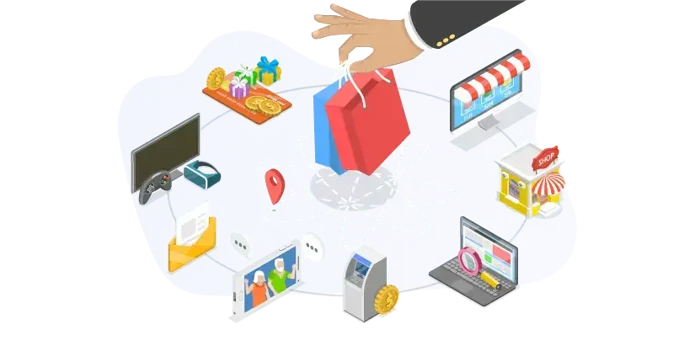
physical-distribution

Source Image: https://www.clickpost.ai/blog/physical-distribution
Physical distribution refers to the transportation of commodities, products, and raw materials from warehouses, factories, and distribution centers to direct delivery of finished items to the end consumer. The process encompasses retail distribution channels, including e-commerce and wholesale, as well as elements like as customer service, inventory management, material procurement, order processing, and transportation.
Physical distribution refers to the movement of finished goods from a company’s distribution and fulfillment network to the end user. In ecommerce, physical distribution involves several ecommerce supply chain activities, including warehousing, inventory control, order processing, retail fulfillment, and shipping. In many cases, physical distribution of goods consists of multiple fulfillment centers within a single distribution network to reduce shipping costs and speed up transit times for customer orders.
- Physical Distribution Objectives
The aims of physical distribution are as follows:
- Customer satisfaction
- Maximization of Profit
- To guarantee the availability of appropriate commodities in the correct amount at the appropriate time and location while minimizing the cost for the requested service.
- To enhance the efficiency of goods transportation and minimize inventory levels.
- To determine the accurate pricing of products through efficient control of physical distribution operations.
- To attain a competitive edge over rivals by delivering superior customer service.
- Factors affecting channel selection
Physical distribution of commodities refers to the process of ensuring that good are accessible to clients at the appropriate time and location. Mainly, it encompasses two dimensions: transportation of commodities by physical means and transportation of commodities by distribution channels. There exist several routes available for the purpose of distributing commodities. Each distribution channel has its own advantages and limitations, and every company must make a difficult choice about the routes of distribution. This decision about the selection of a distribution channel depends on several factors.
Presented below are the factors that influence the channels of distribution in Entrepreneurship and are regarded as factors that impact the context.
Different components’ variables impacting distribution networks
- Marketing factors
Variables relating to the market are crucial as distribution channels search. The selection of distribution channels is directed by a small number of market powers.
The following are some market-related characteristics that should be taken into account when considering natural forces that impact the environment:
- Customers: Getting products into the hands of customers is the end goal of any distribution system. Therefore, while deciding on the distribution channel, it is important to take into account the needs and characteristics of the clientele.
- Contest: The distribution channels that the rivals have set up must be considered. The wisdom and expertise of the candidates were considered in reaching this conclusion. What this also means is that the competition has been using these channels effectively for quite some time. Organizations can take advantage of these distribution channels for climate-related aspects.
- Distribution Methods Now in Use: It is necessary to research the existing distribution channels. When choosing channels, it’s important to consider their capabilities, strengths and weaknesses, stability, and other factors. They should also be thought of in terms of their overall advantages.
- Product factors: Key elements influencing the distribution channels:
When selecting a suitable channel of appropriation, it is necessary to analyze the characteristics of the product that will be distributed. Items vary in their inherent characteristics, and this diversity of products necessitates distinct types of channels that are accountable for the elements influencing climate.
The following product properties must be considered:
- Perishability: When the products are highly perishable, it is advisable to use a short channel or consider a direct marketing approach. The reason for this is that extensive distribution channels with several representatives delay the delivery of goods. Products such as milk and flowers need very rapid dispersion.
- Features of the Product: Consumer goods are purchased by a larger sample of consumers in lower quantities and with more frequency. Therefore, such products necessitate extended distribution channels with a broad scope. Indeed, the existence of retailers is an indisputable necessity. Industrial goods, on the other hand, are purchased in larger quantities by a smaller number of consumers and with less frequency. Furthermore, the contemporary consumer of goods is highly educated, knowledgeable, and prudent. Such products necessitate more restricted distribution channels.
III. Organizational Factors: When selecting a distribution channel, a business must analyse and understand its own characteristics thoroughly. The entity must understand its requirements, resources, and limitations.
The following explicit variables must be understood:
- Financial Strength of the Organization:
A financially robust business has the ability to establish its own distribution channel, therefore leveraging its financial stability. By engaging in negotiations with individuals, it can establish a novel distribution route. A financially weak organization must settle with existing distribution channels, as building new ones takes significant financial resources.
- Corporate reputation:
An exemplary and well-established company with a robust position and reputation will find it easy to have extended distribution channels.
- Channel-Associated Factors: The selection of distribution channels should be appropriate from the perspective of the company. An analysis of these channels should be conducted, followed by the formulation of a suitable decision.
Consider the following relevant variables of the channel:
An Analysis of Channel Capabilities
Well-established and robust channels can effectively transport goods over a vast geographical area. They are able to advertise and market even less familiar products. Recently established distribution channels are unable to engage in these activities. Therefore, an organization must consider the capability of the various channels before choosing the distribution channels.
- Environmental factors refer to characteristics of the environment that influence an organization’s channel decision-making process. The term “environmental” in this context refers to the ambient conditions under which the organization, distribution channels, clients, and other relevant factors are present.
Presented below are several environmental factors that should be taken into account when selecting distribution channels:
- Current Economic Conditions:
The prevailing economic conditions in the country impact all the budgetary operations. Therefore, an organization must be aware of the prevailing economic conditions. In times of economic success, the sales of a wide range of products will often be high, and distribution channels will be enthusiastic in organizing the distribution of these items.
During a period of economic downturn, the total sales decrease due to the reluctance of distribution channels to engage in price allocation. Following are the factors that an organization should take into account while choosing a distribution channel.
- Legal Factors:
The selection of distribution channels by an organization is permissible as long as its activities adhere to legal requirements. There exist some legal considerations that must be taken into account while selecting distribution channels and negotiating with them. Certain types of agreements involving direct distribution as the exclusive distributorship, particularly for specific essential products, may be considered restrictive by law. Therefore, it is necessary to consider such legal components.
- Capital structure:
Financial construction in this context refers to the imposition of particular indirect taxes by state legislatures on goods and services. The analysis lacks coherence and individual instances lack clarity. Therefore, these factors should also be taken into account while choosing distribution channels.
Types of marketing channels
Channels of distribution, alternatively referred to as marketing channels or distribution channels, encompass the sequential routes via which goods or services are transported from the producer or service provider to the ultimate customer. The choice of distribution channels is a vital element of a company’s marketing approach. Multiple channels exist, each fulfilling a distinct function. Outlined below are typical distribution channels:
- Direct sales: Manufacturer to Consumer (DTC): Within this channel, manufacturers engage in direct sales to customers, bypassing any intermediaries. This strategy is customary in the field of electronic commerce, where firms operate online stores or brick-and-mortar stores.
- Retailers: Brick-and-Mortar Retailers: Physical retail outlets are the intermediaries through which products are transported from manufacturers to end consumers. A large variety of products continue to be predominantly distributed through this conventional channel. The proliferation of e-commerce has led to the widespread sale of various products through online merchants. Business enterprises have the option to collaborate with well-established platforms or develop their own e-commerce websites.
- Wholesalers: Merchants Wholesalers are entities that systematically acquire goods in large quantities from manufacturers and thereafter distribute them to retailers. They assume responsibility for the products and manage the logistical operations. An agent or broker is an intermediary who facilitates transactions between buyers and sellers without assuming ownership of the products. As compensation for their services, they receive commissions.
- Distributors: Industrial distributors, typical in B2B environments, serve as mediators between manufacturers and enterprises, facilitating the distribution of products to industrial consumers. Exclusive Distributors: Certain manufacturers designate exclusive distributors for particular geographical areas or market categories, granting them sole privileges to distribute the products.
- Franchises: Franchise Systems: Companies broaden their market presence by granting autonomous entrepreneurs (franchisees) the opportunity to operate under their distinctive brand. Franchisors offer training, merchandise, and frequently promotional materials.
- Agents and representatives: Sales agents are autonomous representatives of manufacturers who market and sell items to independent retailers or other enterprises. Typically, they receive a commission based on sales. Official representatives of the manufacturer: Similar to sales agents, these representatives serve as agents for manufacturers, actively advertising products and arranging transactions.
- Multiple distribution: It refers to the strategic use of several channels by an organization, including direct sales, wholesalers, retailers, and other intermediaries, in order to optimize their market reach and coverage.
- Reverse Channels: Reverse channels encompass the processes of product return, recycling, and disposal, in addition to the forward channels responsible for transporting goods from manufacturers to consumers.
- Supply Chain Partnerships: Collaborative relationships among supply chain partners entail jointly planning and coordinating activities to enhance the efficiency of the distribution process. This may encompass mutually agreed upon logistical, informational, and resource distribution.





